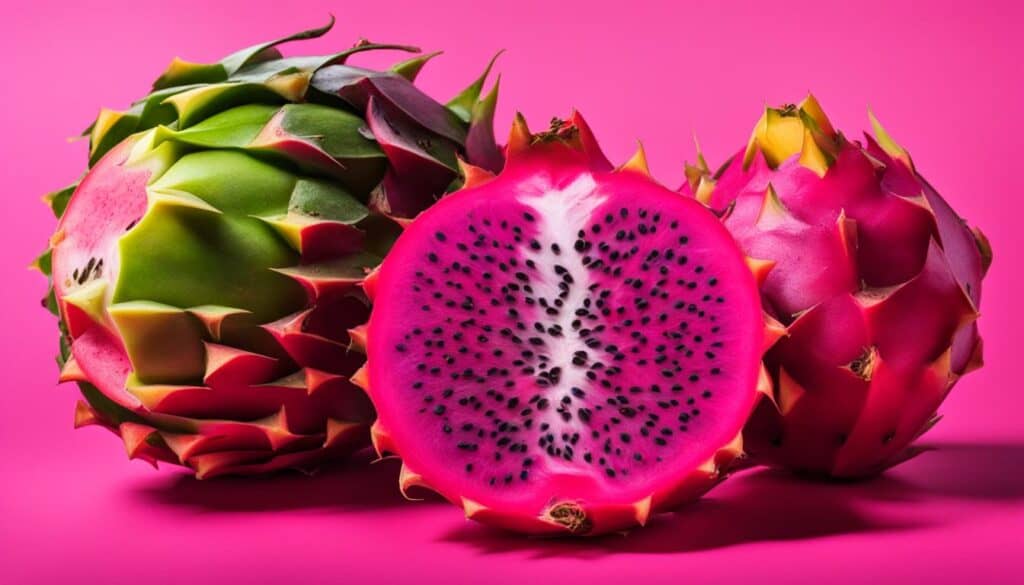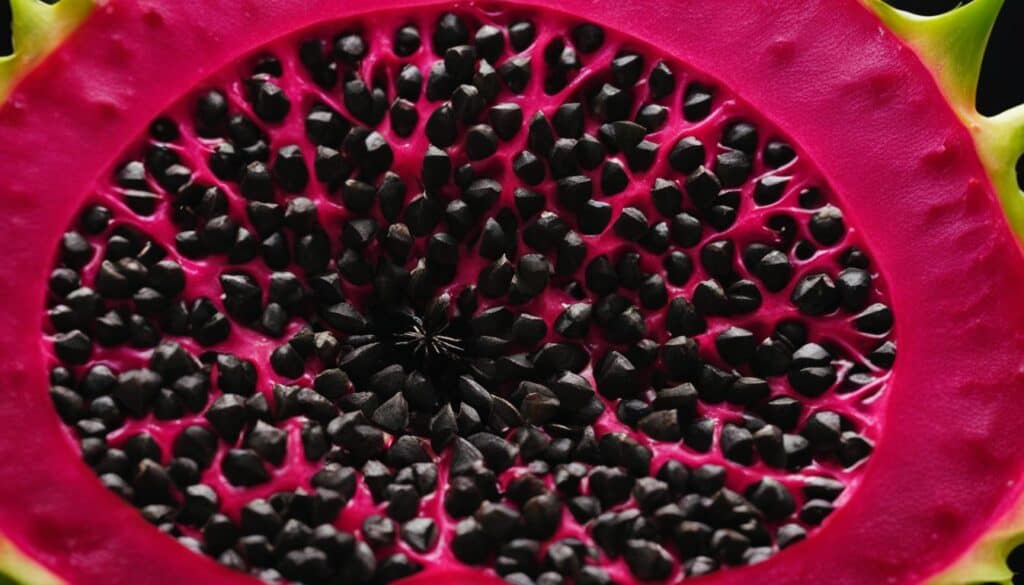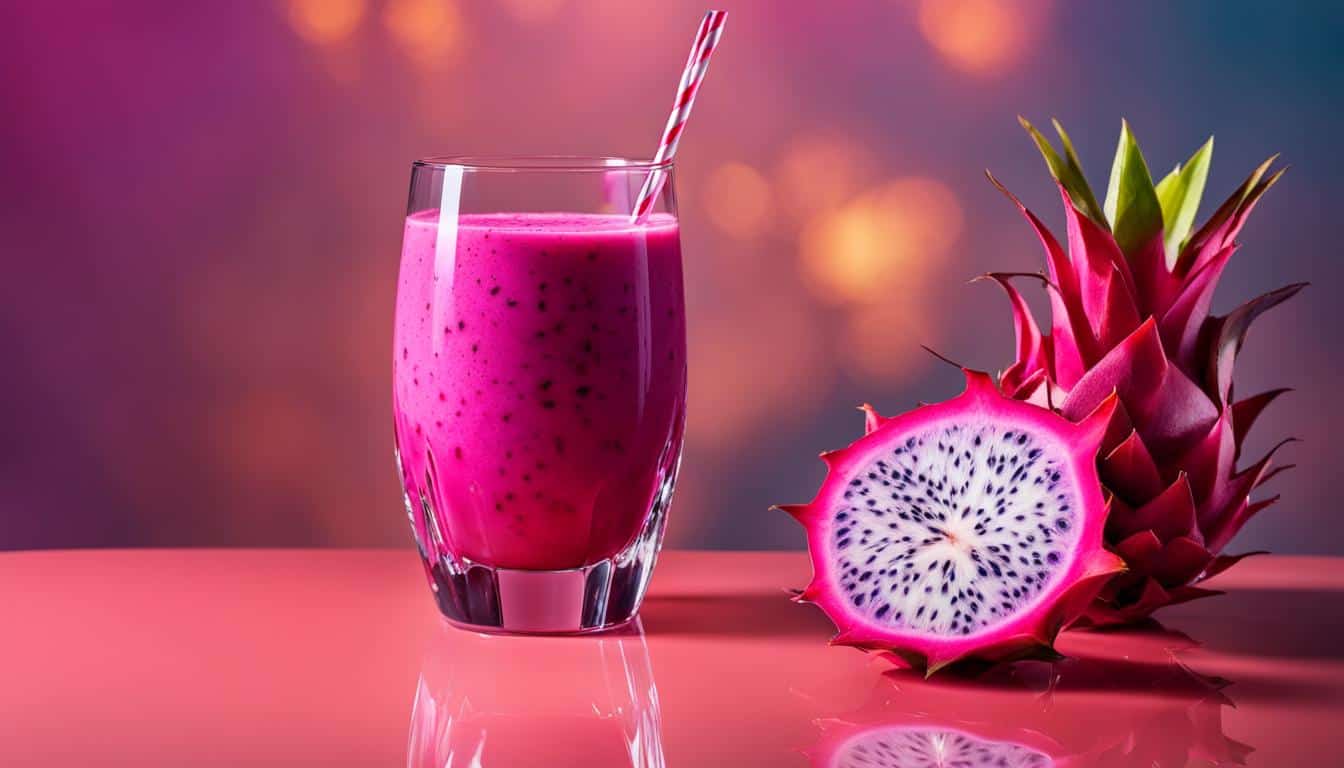Dragon fruit, also known as pitaya, is a vibrant and exotic fruit that captures attention with its stunning red color. Have you ever wondered why dragon fruit is red? In this article, we will explore the fascinating world of dragon fruit pigmentation, its underlying genetics, and the factors that contribute to its natural color.
Dragon fruit’s redness is not simply a superficial attribute; it is a result of enhanced pigmentation within the fruit. The unique genetics of dragon fruit play a crucial role in determining its flesh color, skin color, and overall pigmentation. These genetic factors interact with environmental conditions to produce the captivating red hue that we associate with dragon fruit.
Understanding the natural color of dragon fruit involves delving into the complex world of pigments. The pigmentation of this fruit is primarily influenced by a group of compounds called betacyanins. These red-colored pigments are responsible for the striking reddish hue that is characteristic of dragon fruit.
But what exactly makes dragon fruit red? It boils down to a specific pigment called betanin. Betanin is a type of betacyanin that imparts the rich red color to the flesh and skin of dragon fruit. This pigment is naturally occurring and gives dragon fruit its vibrant appearance.
Dragon fruit’s redness isn’t just for show; it also serves a purpose. The pigmentation compounds found in this fruit, including betanin, act as antioxidants. Antioxidants help protect our bodies from oxidative stress caused by harmful free radicals. Additionally, dragon fruit is packed with vitamins and minerals, making it a nutritious choice for those looking to boost their overall health.
Key Takeaways:
- The red color of dragon fruit is a result of enhanced pigmentation influenced by genetics and natural color.
- Dragon fruit’s natural color is determined by a specific pigment called betanin, which belongs to the betacyanin group.
- Betanin acts as an antioxidant, contributing to the fruit’s health benefits.
- Dragon fruit is not only visually appealing but also a source of vitamins and minerals.
- The next sections will explore the origins, cultivation, culinary uses, health benefits, and varieties of dragon fruit.
The Origins of Dragon Fruit
Dragon fruit, also known as pitaya, has an intriguing history that can be traced back to the lush rainforests of Mexico and Nicaragua. While the exact origins of this exotic fruit remain unclear, it is believed to have been cultivated and consumed by indigenous peoples in Central America for centuries.
The fruit’s fascinating journey continued when it was introduced to Southeast Asia by French colonists in the 19th century. Since then, dragon fruit cultivation has spread to various parts of the world, including countries like Vietnam, Thailand, and Colombia.
Today, dragon fruit is grown commercially in these regions, where farmers harness their expertise to cultivate this tropical delight under optimal conditions. Through careful cultivation practices, the dragon fruit industry continues to thrive, offering consumers an array of vibrant, delicious, and nutritious varieties.
The Growing Conditions for Dragon Fruit
To successfully grow dragon fruit, it is important to provide the right growing conditions. This unique fruit thrives in warm climates and requires well-drained soil for optimal growth and fruit production.
Dragon fruit can be propagated through cutting or grafting. Cutting involves taking a piece of a mature dragon fruit plant and planting it in a suitable growing medium. Grafting involves combining the stem of a desired dragon fruit variety with the rootstock of a different dragon fruit plant. Both methods are effective for propagation.
When it comes to pollination, dragon fruit relies on bats and moths as its primary pollinators. These creatures are attracted to the fragrant flowers of the dragon fruit plant and assist in the transfer of pollen between plants. This natural process is essential for fruit development.
Once the dragon fruit is fully mature, it can be harvested. The fruit is typically ready for harvest when the skin turns bright in color and the scales become plump. Harvesting can be done by gently twisting or cutting the fruit from the plant.
Dragon fruit can be stored in the refrigerator for up to a week, allowing you to enjoy its delicious flavor and numerous health benefits over an extended period of time.
| Dragon Fruit Growing Conditions | Dragon Fruit Propagation | Dragon Fruit Pollination | Dragon Fruit Harvesting |
|---|---|---|---|
| Warm climates | Cutting or grafting | Bats and moths | Bright skin color and plump scales |
| Well-drained soil | Effective methods for propagation | Essential for fruit development | Gentle twisting or cutting |
The Culinary Uses of Dragon Fruit
Dragon fruit, with its vibrant color and unique taste, can be enjoyed in various culinary preparations. From refreshing smoothies to delicious salads and decadent desserts, dragon fruit adds a pop of exotic flavor and visual appeal to your dishes.
Dragon Fruit Smoothies
If you’re looking for a refreshing and nutritious drink, dragon fruit smoothies are a perfect choice. Blend ripe dragon fruit with your favorite fruits, such as bananas, strawberries, or mangoes, along with a splash of coconut water or almond milk. The result is a vibrant, creamy smoothie packed with antioxidants and vitamins.
Dragon Fruit Salads
Add some tropical flair to your salads by incorporating dragon fruit. Slice the fruit into bite-sized pieces and toss it with a medley of fresh greens, such as spinach, arugula, or mixed lettuce. Drizzle with a tangy vinaigrette and sprinkle with toasted almonds or sesame seeds for added texture and crunch.
Dragon Fruit Desserts
Dragon fruit’s vibrant color and mildly tangy flavor make it an excellent ingredient for desserts. Try using it in a fruit tart or parfait for a visually stunning and delicious treat. You can also blend dragon fruit with coconut milk to create a creamy dragon fruit ice cream or sorbet. The possibilities are endless!
Dragon fruit is versatile and can be used in various other culinary creations. Its mild yet distinctive taste pairs well with other tropical flavors and complements both sweet and savory dishes. Get creative and experiment with dragon fruit in your favorite recipes to elevate your culinary creations.
The Health Benefits of Dragon Fruit
Dragon fruit is a powerhouse of nutrition, offering a wide range of health benefits. Packed with antioxidants, vitamins, and fiber, this exotic fruit is an excellent addition to a balanced diet. Let’s take a closer look at how dragon fruit can support your overall well-being.
Antioxidant-Rich
Dragon fruit is known for its high antioxidant content, which helps protect the body against free radicals and oxidative stress. Antioxidants play a crucial role in neutralizing harmful molecules that can damage cells and contribute to chronic diseases.
Immune Support
Vitamin C is an essential nutrient for a healthy immune system and plays a crucial role in preventing and fighting infections. Dragon fruit is a rich source of vitamin C, making it an excellent choice for boosting immunity.
Digestive Health
The fiber content in dragon fruit promotes digestive health by supporting regular bowel movements and preventing constipation. It also helps improve nutrient absorption and maintains a healthy gut microbiome.
| Nutrient | Amount per 100g |
|---|---|
| Vitamin C | 20.5mg |
| Fiber | 1.9g |
| Iron | 0.65mg |
| Calcium | 8.8mg |
Table: Nutritional content of dragon fruit per 100g
These values are approximate and may vary depending on the variety and ripeness of the fruit.
“I love incorporating dragon fruit into my diet because of its amazing health benefits. It’s an antioxidant powerhouse that keeps my immune system strong, and the fiber content aids in my digestion. Plus, it’s so delicious!”
With its impressive array of vitamins, minerals, and fiber, dragon fruit is a nutritious fruit that can contribute to overall health and well-being. Whether enjoyed on its own, added to smoothies, or used in various culinary creations, dragon fruit is a versatile and delicious choice.

The Varieties and Colors of Dragon Fruit
Dragon fruit, also known as pitaya, comes in a variety of colors, each with its own unique characteristics and flavor profile. Let’s explore the different varieties and colors of this exotic fruit!
One of the most popular varieties is the red dragon fruit. This vibrant fruit has a deep red flesh and a slightly sweet taste. It is rich in antioxidants and packed with vitamins C and B, making it a nutritious choice. Red dragon fruit is not only delicious but also visually appealing with its striking color.
Another variety is the white dragon fruit. It has a milder taste compared to the red variety, making it a great option for those who prefer a subtler flavor. The flesh of the white dragon fruit is white, while the skin is usually pink or yellow. Despite its lighter color, white dragon fruit still offers numerous health benefits and is a delightful addition to any dish.
Dragon fruit can also come in shades of purple and pink, which add a unique touch to your culinary creations. Each variety has its own distinct visual appeal and flavor profile, making dragon fruit a versatile ingredient in various dishes and desserts.
Whether you choose the vibrant red dragon fruit or the milder white dragon fruit, you can enjoy the benefits of this exotic fruit while adding a burst of color to your meals. Let your culinary creativity soar with the variety and colors of dragon fruit!
How Dragon Fruit Is Grown and Harvested
Dragon fruit, with its vibrant colors and unique taste, is primarily grown in tropical and subtropical regions. Cultivating dragon fruit requires specific conditions to ensure a successful harvest. Whether it’s through cutting or grafting, dragon fruit farmers employ various methods to propagate this beloved fruit. Let’s explore the process of dragon fruit cultivation, farming, and harvest in more detail.
Dragon Fruit Cultivation
Dragon fruit cultivation involves creating an ideal environment for the fruit to thrive. A warm climate is essential, with temperatures ranging from 65°F to 90°F (18°C to 32°C). The fruit requires at least six hours of direct sunlight per day.
Well-drained soil is crucial for the proper growth of dragon fruit. It is recommended to use sandy or loamy soil with a pH level between 6 and 7.5. Additionally, regular irrigation is necessary to keep the soil moist but not waterlogged.
Dragon Fruit Farming
Dragon fruit farming entails the careful management of the cultivation process. Farmers need to regularly monitor the plants’ health, ensuring they are free from pests and diseases. Proper nutrition, including regular fertilization with organic matter, helps promote healthy growth.
Dragon fruit plants need support as they grow, so trellises or other structures are used to hold the branches upright. This not only prevents damage to the fruit but also provides ample space for the plants to spread and soak in the sunlight.
Dragon Fruit Harvest
The time to harvest dragon fruit is when it is fully ripe. The fruit should have a vibrant color, whether it’s the classic red variety or other varieties like white or pink. The scales on the fruit’s skin should be plump, indicating a ripe fruit that’s ready to be enjoyed.
When harvesting dragon fruit, it’s important to handle the fruit gently to avoid bruising. After harvest, the fruit can be stored in the refrigerator for a short period to maintain its freshness and taste before consumption.
“Dragon fruit cultivation requires a warm climate, well-drained soil, and careful monitoring to ensure a successful harvest.”
With the right conditions and proper care, dragon fruit can be cultivated, farmed, and harvested to provide a delicious and nutritious addition to our diet. Exploring the world of dragon fruit opens up a world of taste and color, inviting us to experience the wonders of nature’s bounty.
The Different Aspects of Dragon Fruit
Dragon fruit, also known as pitaya, is a fascinating fruit that offers various distinctive aspects. Let’s explore some of them:
Dragon Fruit Seeds
Dragon fruit contains small black seeds that are not only edible but also provide a delightful crunch when consumed. These seeds add an interesting texture to the fruit, enhancing the overall eating experience.
Dragon Fruit Flower
The flowers of dragon fruit are not only aesthetically pleasing but also highly fragrant. These vibrant flowers release a captivating scent that attracts pollinators like bats and moths. Their presence is essential for the reproduction and fruiting of dragon fruit plants.
Dragon Fruit Flesh
The flesh of dragon fruit is where the magic lies. It can range in color from white to deep red, offering a visual treat to the eyes. Each variety of dragon fruit has its own distinct taste and texture, making it a fascinating fruit to explore.
To visualize the different aspects of dragon fruit, take a look at the image below:

The Nutritional Value of Dragon Fruit
Dragon fruit is not only visually stunning but also highly nutritious and beneficial for our health. It is packed with essential vitamins and minerals that contribute to overall well-being.
One of the key nutritional benefits of dragon fruit is its high vitamin C content. Vitamin C is a powerful antioxidant that helps support the immune system and promotes healthy skin. Consuming dragon fruit can help boost your body’s defense against common illnesses and keep your skin glowing.
In addition to vitamin C, dragon fruit is a good source of fiber. Fiber plays a crucial role in maintaining a healthy digestive system and preventing constipation. Including dragon fruit in your diet can help improve digestion and promote regular bowel movements.
Dragon fruit is also rich in iron, an essential mineral that helps transport oxygen throughout the body. Iron is particularly important for individuals with iron deficiency anemia, as it helps replenish iron stores and promotes healthy red blood cell production.
Furthermore, dragon fruit contains calcium, which is essential for maintaining strong bones and teeth. Adequate calcium intake is crucial for individuals of all ages to support bone health and reduce the risk of osteoporosis.
To summarize, here is a breakdown of the key nutrients found in dragon fruit:
| Nutrient | Amount per 100g |
|---|---|
| Vitamin C | 20.5mg |
| Fiber | 1.9g |
| Iron | 0.7mg |
| Calcium | 8.8mg |
Enjoying dragon fruit as part of a balanced diet can provide you with these essential nutrients and contribute to your overall health and well-being.
Conclusion
Dragon fruit is truly a remarkable fruit that captivates both the eyes and the taste buds. Its vibrant red color is a result of enhanced pigmentation, influenced by genetics and its natural color. But it’s not just about the appearance; dragon fruit is also a nutritional powerhouse. Packed with antioxidants, vitamins, and fiber, it offers a plethora of health benefits that make it a fantastic addition to any diet.
By incorporating dragon fruit into your meals, you can enjoy the natural goodness it provides. Whether you prefer the rich and slightly tart flavor of red dragon fruit or the milder taste of the white variety, both options offer unique culinary uses. Dragon fruit can be blended into refreshing smoothies, tossed into vibrant salads, or used in delightful desserts.
So, why not embrace the allure of the dragon fruit? It’s not just about its mesmerizing red color, but also the countless benefits it brings to your table. With its delicious taste and remarkable nutritional profile, dragon fruit is a fruit worth savoring. Try it for yourself and discover the wonders of this exotic fruit.
FAQ
Why is dragon fruit red?
Dragon fruit is red due to enhanced pigmentation, which is influenced by its genetics and natural color. The red color is a result of the fruit’s unique pigments.
Is all dragon fruit red in color?
No, dragon fruit comes in various colors, including red, white, purple, and pink. The red dragon fruit is higher in antioxidants and vitamins, while white dragon fruit has a milder taste.
How is dragon fruit grown?
Dragon fruit can be propagated through cutting or grafting. It requires a warm climate and well-drained soil to thrive.
How is dragon fruit harvested?
Dragon fruit is harvested when the skin turns bright in color and the scales are plump. It is typically harvested when fully ripe and can be stored for a short period of time in the refrigerator.
What are the culinary uses of dragon fruit?
Dragon fruit can be eaten raw or used in various culinary preparations. It is commonly used in smoothies, salads, and desserts due to its unique texture and mildly tangy flavor.
What are the health benefits of dragon fruit?
Dragon fruit is packed with antioxidants, vitamins, and fiber, making it a nutritious addition to the diet. It is particularly high in vitamin C and fiber, which support immune function and digestive health.
What are the varieties and colors of dragon fruit?
Dragon fruit comes in various colors, including red, white, purple, and pink. Each variety has its own unique characteristics and flavor profile.
What is the nutritional value of dragon fruit?
Dragon fruit is a highly nutritious fruit that is rich in vitamins and minerals. It is a good source of vitamin C, fiber, iron, and calcium.
How long can dragon fruit be stored?
Dragon fruit can be stored in the refrigerator for up to a week.





Leave a Reply